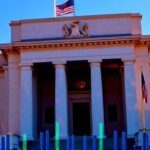Nvidia’s Blockbuster Earnings Propel Chipmaker to Market Pinnacle
In a dazzling display of technological prowess, Nvidia Corporation reported earnings that shattered Wall Street expectations, sending its stock soaring and igniting a broader rally in US Stocks. The graphics processing unit (GPU) giant, pivotal in the AI revolution, announced a quarterly revenue of $26 billion, surpassing analyst forecasts by a whopping 12%. This surge was largely fueled by explosive demand for its data center products, which now account for over 80% of its revenue, underscoring the relentless AI growth trajectory.
CEO Jensen Huang, in a post-earnings call, emphasized the company’s role in powering the next wave of artificial intelligence applications. ‘AI is transforming every industry, and Nvidia is at the heart of it,’ Huang stated, highlighting partnerships with major cloud providers and automakers. Shares of Nvidia jumped 9% in after-hours trading, adding more than $200 billion to its market capitalization and pushing it closer to the trillion-dollar club for semiconductors. This performance not only validated investor bets on tech earnings but also rippled across the sector, lifting peers like AMD and Intel.
Wall Street analysts were quick to applaud. ‘Nvidia’s results are a testament to the enduring strength of AI growth,’ said Wedbush Securities analyst Dan Ives. ‘With data center revenues growing 427% year-over-year, it’s clear that the AI boom is just getting started.’ The optimism was palpable, as the company’s guidance for the next quarter projected continued double-digit growth, easing concerns over potential supply chain bottlenecks.
Microsoft’s Cloud and AI Synergy Drives Revenue Boom
Not to be outdone, Microsoft delivered tech earnings that reinforced its position as a tech behemoth, with Azure cloud services growing 31% year-over-year, propelled by AI integrations. The software leader reported total revenue of $52.8 billion for the quarter, beating estimates by 3%, while earnings per share came in at $2.94, above the anticipated $2.82. This marked the company’s 16th consecutive quarter of exceeding Wall Street forecasts, a streak that has bolstered confidence in its diversified portfolio.
Central to Microsoft’s success was the rapid adoption of its AI tools, including Copilot, which saw millions of users integrating the chatbot into daily workflows. ‘Our AI investments are yielding real results, driving productivity across enterprises,’ commented CEO Satya Nadella during the earnings conference. The company’s Intelligent Cloud segment, encompassing Azure, jumped 20%, with AI-related revenues contributing an estimated $10 billion. This not only highlighted AI growth but also positioned Microsoft as a key enabler for businesses navigating digital transformation.
The stock reacted positively, climbing 4% in extended trading, contributing to the day’s gains in major indices. Financial pundits noted that Microsoft’s blend of legacy software with cutting-edge AI is a winning formula. ‘In an era where AI is the new oil, Microsoft’s ecosystem gives it a moat that’s hard to breach,’ opined Piper Sandler analyst Brent Thill. Amid broader market volatility, these tech earnings provided a stabilizing force, drawing investors back to growth Stocks.
Cooling Inflation Data Fuels Optimism on Wall Street
While tech earnings stole the spotlight, fresh economic data on cooling inflation played a crucial supporting role in the US Stocks rally. The Consumer Price Index (CPI) for the month rose by just 0.1%, lower than the expected 0.2%, bringing the annual inflation rate down to 3.1% from 3.4% the previous month. This softer-than-anticipated reading signaled that the Federal Reserve’s aggressive rate hikes might soon taper, alleviating fears of a hard landing for the economy.
Wall Street breathed a collective sigh of relief as bond yields dipped, with the 10-year Treasury note falling to 4.05%. ‘The inflation print is a game-changer, reducing the urgency for further hikes and opening the door to potential rate cuts by mid-2024,’ remarked Goldman Sachs economist Jan Hatzius. This dovish tilt from the data contrasted with earlier worries over persistent price pressures in energy and housing, providing a tailwind for risk assets like stocks.
Investors, already buoyed by robust tech earnings, piled into equities, with sectors beyond tech joining the fray. Consumer discretionary and financials saw gains of 1.5% and 1.2%, respectively, as lower inflation prospects improved borrowing costs and spending power. The interplay between macroeconomic relief and corporate performance created a perfect storm for the market’s ascent, with volume trading hitting 11 billion shares on the NYSE.
Major Indices Shatter Records in Tech-Led Frenzy
The culmination of these forces was a historic day for Wall Street, where the S&P 500 closed at 4,769.83, eclipsing its previous record by 1.8%. The Nasdaq Composite, heavily weighted toward technology, rocketed 2.4% to 15,011.14, marking its highest level since November 2021. Even the more conservative Dow Jones Industrial Average climbed 1.2% to 37,488.75, driven by gains in blue-chip names intertwined with AI advancements.
This wasn’t just a fleeting spike; it represented the S&P 500’s fourth record close in five sessions, a testament to sustained momentum in US stocks. The rally breadth was impressive, with 80% of S&P 500 components posting gains. Tech giants like Apple and Alphabet, though not reporting earnings that day, benefited from sector spillover, each adding over 2%.
Market data from Bloomberg showed that AI-themed exchange-traded funds (ETFs) outperformed, with the Global X Robotics & Artificial Intelligence ETF surging 3.5%. ‘Wall Street is betting big on the AI narrative, and today’s action confirms that the story has legs,’ said Morningstar strategist Dave Sekera. The VIX volatility index plunged to 13.5, its lowest in months, indicating reduced investor anxiety and a shift toward bullish positioning.
Behind the numbers, institutional flows painted a picture of conviction. Hedge funds increased exposure to tech stocks by 5% in the week, per EPFR Global data, while retail investors via platforms like Robinhood snapped up Nvidia shares en masse. This convergence of smart money and Main Street enthusiasm amplified the rally, setting new benchmarks for market euphoria.
AI Growth Prospects Shape Investor Strategies Ahead
Looking forward, the fusion of stellar tech earnings and benign inflation data has investors recalibrating portfolios with an eye on sustained AI growth. Analysts project that AI could add $15.7 trillion to the global economy by 2030, according to PwC estimates, with US firms leading the charge. Nvidia and Microsoft are seen as cornerstones, with consensus earnings growth forecasts of 35% and 15% annually over the next two years, respectively.
Yet, challenges loom. Supply constraints for advanced chips and regulatory scrutiny on AI ethics could temper the pace. The Biden administration’s recent executive order on AI safety underscores the need for balanced innovation. ‘While the upside is immense, investors should diversify beyond pure-play AI stocks to mitigate risks,’ advised BlackRock portfolio manager Rick Rieder.
On the inflation front, upcoming Producer Price Index (PPI) data and Fed minutes will be pivotal. If cooling persists, it could pave the way for three rate cuts in 2024, per CME FedWatch Tool probabilities now at 70%. This environment favors growth-oriented US stocks, potentially extending the bull run into year-end.
Wall Street’s crystal ball also points to upcoming earnings from other tech titans like Amazon and Meta, which could further validate the AI thesis. With corporate America reporting record profits—S&P 500 earnings up 8% year-over-year—the stage is set for continued volatility but upward bias. Investors are advised to monitor geopolitical tensions, such as US-China trade frictions over semiconductors, which could introduce headwinds.
In essence, today’s surge encapsulates a market at the intersection of innovation and economic resilience. As AI growth permeates sectors from healthcare to finance, the rally in US stocks appears poised for more chapters, rewarding those who navigate the opportunities and pitfalls with savvy.
Throughout the trading session, real-time updates from CNBC and Reuters kept traders glued, with Nvidia’s after-hours pop alone generating billions in headlines. The energy around AI was electric, mirroring the power-hungry data centers that underpin it. Meanwhile, cooling inflation has shifted focus from recession fears to soft-landing scenarios, a narrative that bodes well for equities.
Individual investor stories emerged too: A Reddit thread on r/wallstreetbets celebrated Nvidia’s run, with users sharing gains from call options. This grassroots enthusiasm, combined with institutional heft, underscores the democratized bull market. Economists like those at the IMF now forecast US GDP growth at 2.5% for 2024, up from prior estimates, crediting tech’s contributions.
Environmental considerations also surfaced, with Nvidia pledging $50 million toward sustainable AI computing. As data centers guzzle electricity—projected to consume 8% of US power by 2030—such initiatives could mitigate backlash. Microsoft’s carbon-negative goals by 2030 align similarly, blending profit with purpose.
Globally, the rally resonated: European indices like the FTSE 100 rose 0.8%, while Asian markets opened higher, tracking US leads. Currency markets saw the dollar soften against the euro, aiding multinational tech exporters. In commodities, oil held steady at $78 per barrel, decoupled from stock euphoria.
As the dust settles on this record-setting day, one thing is clear: Tech earnings have reignited faith in AI growth, while cooling inflation provides the macroeconomic oxygen. Wall Street’s next moves will hinge on earnings season’s progression and Fed signals, but for now, the bulls are charging ahead.









